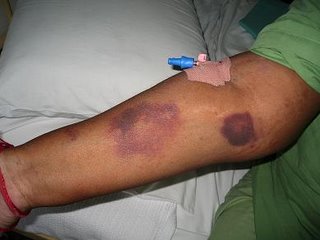Cushing's Syndrome

 I would be keen to examine this lady's blood pressure and dipstick the urine for evidence of overt glycosuria and proteinuria. I also would like to complete my examination by checking the visual fields and performing a funduscopy to look for evidence of retinopathy and papilloedema. A history of steroid usage is of prudent importance in this patient.
I would be keen to examine this lady's blood pressure and dipstick the urine for evidence of overt glycosuria and proteinuria. I also would like to complete my examination by checking the visual fields and performing a funduscopy to look for evidence of retinopathy and papilloedema. A history of steroid usage is of prudent importance in this patient.
This lady has Cushing's syndrome as evidenced by the presence of moon-face associated with hirsutism and acne. There are buffalo hump and truncal obesity as well. There is thinning of the skin with localised bruises especially over the cubital fossae of both arms. However there is no purplish striae noted on the abdomen and inner thighs. There is no oral thrush. Patient has proximal weakness. The back is straight with no features of kyphoscoliosis.
Questions:
1. What are the causes of Cushing's syndrome?
Outline: Pituitary-driven, adrenal and ectopic or iatrogenic sources.
3. What are the other tests to determine the source of ACTH (to distinguish primary from ectopic)?
4. How would you manage Cushing's syndrome?
5. What is Nelson's syndrome?








5 Comments:
Courtesy of wuchereria, who post this blog together with me:)
Thanks, axonopathic.
Most of the time, Cushing's syndrome in PACES is due to iatrogenic cause. Any signs to suggest gout, RA, asthma, fibrosing alveolitis, SLE, nephrotic syndrome....
she does not seem to have acne; the hirsutism seem to be "?racial" (mainly in her forehead, her chin is clear). We are used to see Cushingoid faces of westerens; this is difficult to us to see an Asian with Cushing's syn. (no plethoa can be seen , and the telangiectasiae would be easily missed)!
Dr. O Amin
Definitely, emrcpian. I look hard for the possible etiologies that you've mentioned but I'd found none.
To saramin: She does have acne if look closely enough. Sorry the original picture file has been resized to suit this blog. Thanks for the great tip!
actually, a high dose dex suppression, when used (not all think this is a reliable enougn test), might be more helpful in determining the source of ACTH in an established ACTH-dependent Cushing's (ie ectopic which has little response versus cushing's dz, which may still partially suppress). it's not really used to localize the source of excess cortisol.
Post a Comment
<< Home